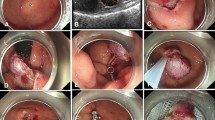Abstract
Background and aims
This retrospective study evaluated the safety and efficacy of endoscopic full-thickness resection (eFTR) with defect closure using clips and an endoloop for the treatment of gastric subepithelial tumors (SETs) arising from the muscularis propria (MP).
Methods
From January 2009 to December 2012, 51 patients with gastric SETs arising from the MP underwent eFTR with defect closure using clips and an endoloop. The key steps were (1) several milliliters of mixture solution was injected into the submucosa after dots were marked around the tumor; (2) a cross incision was made in the mucosa to reveal the tumor; (3) subsequently, circumferential excavation was performed as deep as the muscularis propria, and full-thickness resection of the tumor was performed with an insulated-tip knife, including its underlying MP and serosa; (4) the gastric wall defect was closed with clips and an endoloop was then placed to fix and tighten all of the clips together.
Results
Successful complete resection by eFTR was achieved in 50 cases (98.0 %). One case failed and was converted into a laparoscopic resection due to the tumor falling into the peritoneal cavity during the procedure. The mean procedure time was 52 min. No patients had severe complications, such as massive bleeding, delayed bleeding, peritonitis, or gastrointestinal tract leakage. The mean tumor length was 2.4 cm. Pathological diagnoses of the tumors were leiomyomas (21/51) and gastrointestinal stromal tumors (30/51). The median follow-up period after the procedure was 22.4 months (range 1–48 months), and no residual tumor or tumor recurrence was detected during the follow-up period.
Conclusions
eFTR with defect closure with clips and an endoloop appears to be a safe and effective technique for the treatment of patients with gastric SETs originating from the MP, especially for those with extraluminal growth or adhesions to the MP.

Similar content being viewed by others
References
Akahoshi K, Sumida Y, Matsui N et al (2007) Preoperative diagnosis of gastrointestinal stromal tumor by endoscopic ultrasound-guided fine needle aspiration. World J Gastroenterol 13:2077–2082
Miettinen M, Sobin LH, Lasota J (2005) Gastrointestinal stromal tumors of the stomach: a clinicopathologic, immunohistochemical, and molecular genetic study of 1,765 cases with long term follow-up. Am J Surg Pathol 29:52–68
Demetri GD, von Mehren M, Antonescu CR et al (2010) NCCN Task Force report: update on the management of patients with gastrointestinal stromaltumors. J Natl Compr Canc Netw 8(Suppl 2):S1–S41
Sasaki A, Koeda K, Obuchi T et al (2010) Tailored laparoscopic resection for suspected gastric gastrointestinal stromal tumors. Surgery 147:516–520
De Vogelaere K, Van Loo I, Peters O et al (2012) Laparoscopic resection of gastric gastrointestinal stromal tumors (GIST) is safe and effective, irrespective of tumor size. Surg Endosc 26:2339–2345
Li QL, Yao LQ, Zhou PH et al (2012) Submucosal tumors of the esophagogastric junction originating from the muscularis propria: a large study of endoscopic submucosal dissection (with video). Gastrointest Endosc 75:1153–1158
Zhang Y, Ye LP, Zhu LH et al (2013) Endoscopic muscularis excavation for subepithelial tumors of the esophagogastric junction originating from the muscularis propria. Dig Dis Sci 58(5):1335–1340
Mangiavillano B, Viaggi P, Masci E (2010) Endoscopic closure of acute iatrogenic perforations during diagnostic and therapeutic endoscopy in the gastrointestinal tract using metallic clips: a literature review. J Dig Dis 11(1):12–18
Yoshizumi F, Yasuda K, Kawaguchi K et al (2009) Submucosal tunneling using endoscopic submucosal dissection for peritoneal access and closure in natural orifice transluminal endoscopic surgery: a porcine survival study. Endoscopy 41(8):707–711
Zhou PH, Yao LQ, Qin XY et al (2011) Endoscopic full-thickness resection without laparoscopic assistance for gastric submucosaltumors originated from the muscularis propria. Surg Endosc 25:2926–2931
Kaehler G, Grobholz R, Langner C et al (2006) A new technique of endoscopic full-thickness resection using a flexible stapler. Endoscopy 38(1):86–89
Ikeda K, Fritscher-Ravens A, Mosse CA et al (2005) Endoscopic full-thickness resection with sutured closure in a porcine model. Gastrointest Endosc 62(1):122–129
Evans JA, Rosato FE, Ginsberg GG (2007) Gastrostomy port assisted full-thickness gastric resection by using the peroral SurgASSIST introduced via an oroesophageal overtube in a porcine model. Gastrointest Endosc 65(4):684–687
von Renteln D, Schmidt A, Vassiliou MC et al (2010) Endoscopic full-thickness resection and defect closure in the colon. Gastrointest Endosc 71(7):1267–1273
Białek A, Wiechowska-Kozłowska A, Pertkiewicz J et al (2012) Endoscopic submucosal dissection for treatment of gastric subepithelial tumors. Gastrointest Endosc 75:276–286
Mukai S, Cho S, Kotachi T et al (2012) Analysis of delayed bleeding after endoscopic submucosal dissection for gastric epithelial neoplasms. Gastroenterol Res Pract 2012:875323
Ye LP, Zhang Y, Mao XL et al (2013) Submucosal tunnelling endoscopic resection for treatment of esophageal submucosal tumours originating from the muscularis propria: an analysis of 15 cases. Dig Liver Dis 45(2):119–123
Maeda Y, Hirasawa D, Fujita N et al (2012) A pilot study to assess mediastinal emphysema after esophageal endoscopic submucosal dissection with carbon dioxide insufflation. Endoscopy 44(6):565–571
Akahoshi K, Oya M (2010) Gastrointestinal stromal tumor of the stomach: how to manage? World J Gastrointest Endosc 2(8):271–277
Lee HH, Hur H, Jung H et al (2011) Analysis of 151 consecutive gastric submucosal tumors according to tumor location. J Surg Oncol 104(1):72–75
Acknowledgments
This study was supported as a project of the Zhejiang province bureau of health (2013KYA229).
Disclosures
Li-Ping Ye, Yu Zhang, Xin-Li Mao, Lin-hong Zhu, and Xian-Bin Zhou have no conflicts of interest exist relating to this study.
Author information
Authors and Affiliations
Corresponding author
Electronic supplementary material
Below is the link to the electronic supplementary material.
Supplementary material 1 (MP4 42166 kb)
Rights and permissions
About this article
Cite this article
Ye, LP., Yu, Z., Mao, XL. et al. Endoscopic full-thickness resection with defect closure using clips and an endoloop for gastric subepithelial tumors arising from the muscularis propria. Surg Endosc 28, 1978–1983 (2014). https://doi.org/10.1007/s00464-014-3421-1
Received:
Accepted:
Published:
Issue Date:
DOI: https://doi.org/10.1007/s00464-014-3421-1




